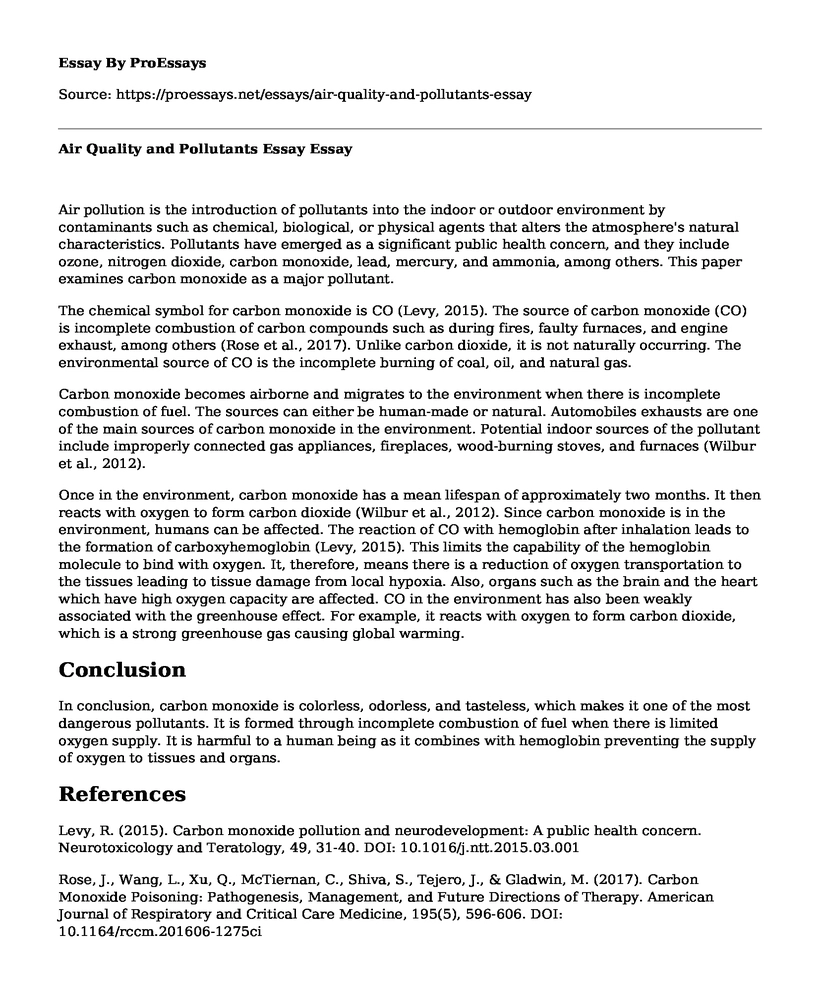Air pollution is the introduction of pollutants into the indoor or outdoor environment by contaminants such as chemical, biological, or physical agents that alters the atmosphere's natural characteristics. Pollutants have emerged as a significant public health concern, and they include ozone, nitrogen dioxide, carbon monoxide, lead, mercury, and ammonia, among others. This paper examines carbon monoxide as a major pollutant.
The chemical symbol for carbon monoxide is CO (Levy, 2015). The source of carbon monoxide (CO) is incomplete combustion of carbon compounds such as during fires, faulty furnaces, and engine exhaust, among others (Rose et al., 2017). Unlike carbon dioxide, it is not naturally occurring. The environmental source of CO is the incomplete burning of coal, oil, and natural gas.
Carbon monoxide becomes airborne and migrates to the environment when there is incomplete combustion of fuel. The sources can either be human-made or natural. Automobiles exhausts are one of the main sources of carbon monoxide in the environment. Potential indoor sources of the pollutant include improperly connected gas appliances, fireplaces, wood-burning stoves, and furnaces (Wilbur et al., 2012).
Once in the environment, carbon monoxide has a mean lifespan of approximately two months. It then reacts with oxygen to form carbon dioxide (Wilbur et al., 2012). Since carbon monoxide is in the environment, humans can be affected. The reaction of CO with hemoglobin after inhalation leads to the formation of carboxyhemoglobin (Levy, 2015). This limits the capability of the hemoglobin molecule to bind with oxygen. It, therefore, means there is a reduction of oxygen transportation to the tissues leading to tissue damage from local hypoxia. Also, organs such as the brain and the heart which have high oxygen capacity are affected. CO in the environment has also been weakly associated with the greenhouse effect. For example, it reacts with oxygen to form carbon dioxide, which is a strong greenhouse gas causing global warming.Conclusion
In conclusion, carbon monoxide is colorless, odorless, and tasteless, which makes it one of the most dangerous pollutants. It is formed through incomplete combustion of fuel when there is limited oxygen supply. It is harmful to a human being as it combines with hemoglobin preventing the supply of oxygen to tissues and organs.
References
Levy, R. (2015). Carbon monoxide pollution and neurodevelopment: A public health concern. Neurotoxicology and Teratology, 49, 31-40. DOI: 10.1016/j.ntt.2015.03.001
Rose, J., Wang, L., Xu, Q., McTiernan, C., Shiva, S., Tejero, J., & Gladwin, M. (2017). Carbon Monoxide Poisoning: Pathogenesis, Management, and Future Directions of Therapy. American Journal of Respiratory and Critical Care Medicine, 195(5), 596-606. DOI: 10.1164/rccm.201606-1275ci
Wilbur, S., Williams, M., Williams, R., Scinicariello, F., Klotzbach, J., Diamond, G., & Citra, M. (2012). Toxicological Profile for Carbon Monoxide. Retrieved 28 September 2019, from https://www.atsdr.cdc.gov/toxprofiles/tp201.pdf
Cite this page
Air Quality and Pollutants Essay. (2022, Mar 28). Retrieved from https://proessays.net/essays/air-quality-and-pollutants-essay
If you are the original author of this essay and no longer wish to have it published on the ProEssays website, please click below to request its removal:
- Ecology Essay Example on Environmental Impact
- Hazed and Confused: The Effect of Air Pollution on Dementia
- Pyrolysis as a Modeling Approach to Saving Energy Usage - Essay Sample
- High-Risk Behaviors Seen in Schools, Emergency Management and Disaster Planning
- Essay Example on Deep Water Horizon Disaster: The Deadly Oil Spill of 2010
- Global Warming: Causes, Effects & Solutions - Essay Sample
- Report Example on Management of Stormwater







